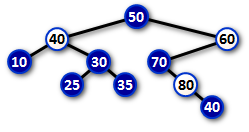Search Nodes in a Binary Tree
Let T be an unempty general rooted binary tree in which each node contains one integer key.
We say that a node N in T is a so called search node if one of the following conditions holds:
- N is a leaf.
- N has only left child L and the key of L is less than the key of N.
- N has only right child R and the key of N is less than the key of R.
- N has left child L and right child R and the key of L is less than the key of N which is less than the key of R.
Binary tree coding
Any binary tree which nodes contain a single key can be coded by a string composed only of parentheses and key values. We define the code of the tree recursively as follows (the quotation marks are not part of the defined string):
- An empty tree is coded by empty string "".
- A tree with a single node is coded by the string "
(A)", whereAis the string representation of the root's key. - A tree with more than one node is coded by the string "
(ABC)" whereAis the code of the left subtree of the root,Bis the string representation of the root's key andCis the code of the right subtree of the root.
(((1)2(3))4((5)6(7)))".Note that the order in which the keys appear in the code is identical with the order produced by the Inorder traversal of the tree.
 Image 1. A binary tree with its search nodes depicted in dark blue. The tree code is " (((10)40((25)30(35)))50((70(80(40)))60))". The tree is an illustration of Example 1 bellow.
|
The task
You are given a binary tree in its coded form. Find the number of search nodes in this tree.
Technical hintTo analyse small examples you may utilise a suitable programmer's editor which highlights matching brackets in the code. When you paste the tree code into the editor then the highlighted matching brackets indicate the extent of a particular subtree in the tree code.
Input
There is a single input line. It contains the code of a binary tree. The keys in the tree are all positive and less than 10000.
The line contains only left and right round parentheses and digits 0, 1, ..., 9 and no other symbols.
The number of the nodes in the tree does not exceed 106.
Output
The output contains one text line with one integer representing the total number of search nodes in the given tree.
Example 1
Input(((10)40((25)30(35)))50((70(80(40)))60))Output 7 |
________50________
__40____ ______60
10 __30__ 70__
25 35 80__
40
Scheme 1. The tree in Example 1. The search nodes are also depicted in Image 1.
|
Example 2
Input(((70)60(50))40((30)20(10)))Output 4 |
____40____
__60__ __20__
70 50 30 10
Scheme 2. The tree in Example 2.
|
Example 3
Input(((((20)12(14((((12)15)19)10(14))))16(17(((11)18)20(14(10)))))10(((10(16))19)18(19(20(17(17))))))16((11)13))Output
17
__________________16____
______________10________ __13
______________16__ __18__ 11
__12__ 17______ ____19 19__
20 14________ __20__ 10__ 20__
__10__ __18 14__ 16 17__
__19 14 11 10 17
__15
12
Scheme 3. The tree in Example 3.
Public data
The public data set is intended for easier debugging and approximate program correctness checking. The public data set is stored also in the upload system and each time a student submits a solution it is run on the public dataset and the program output to stdout and stderr is available to him/her.
Link to public data set